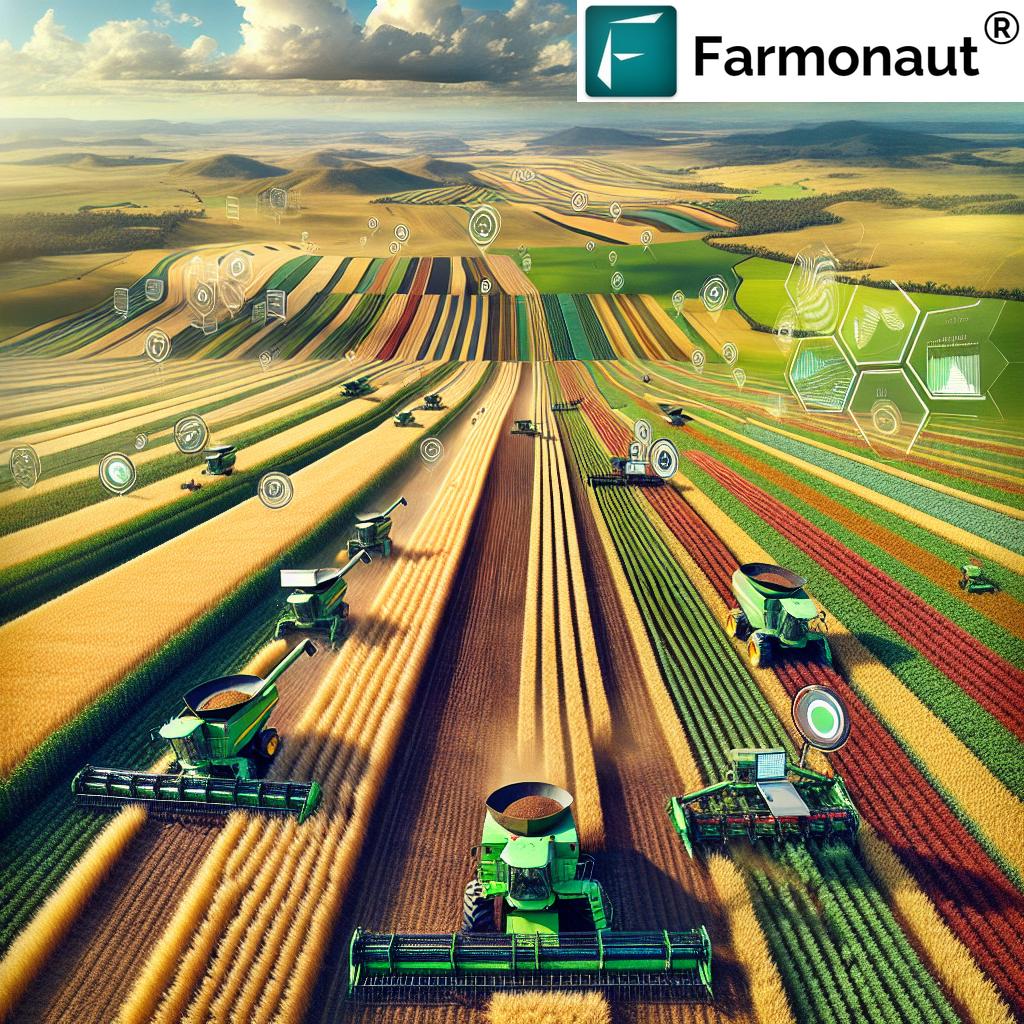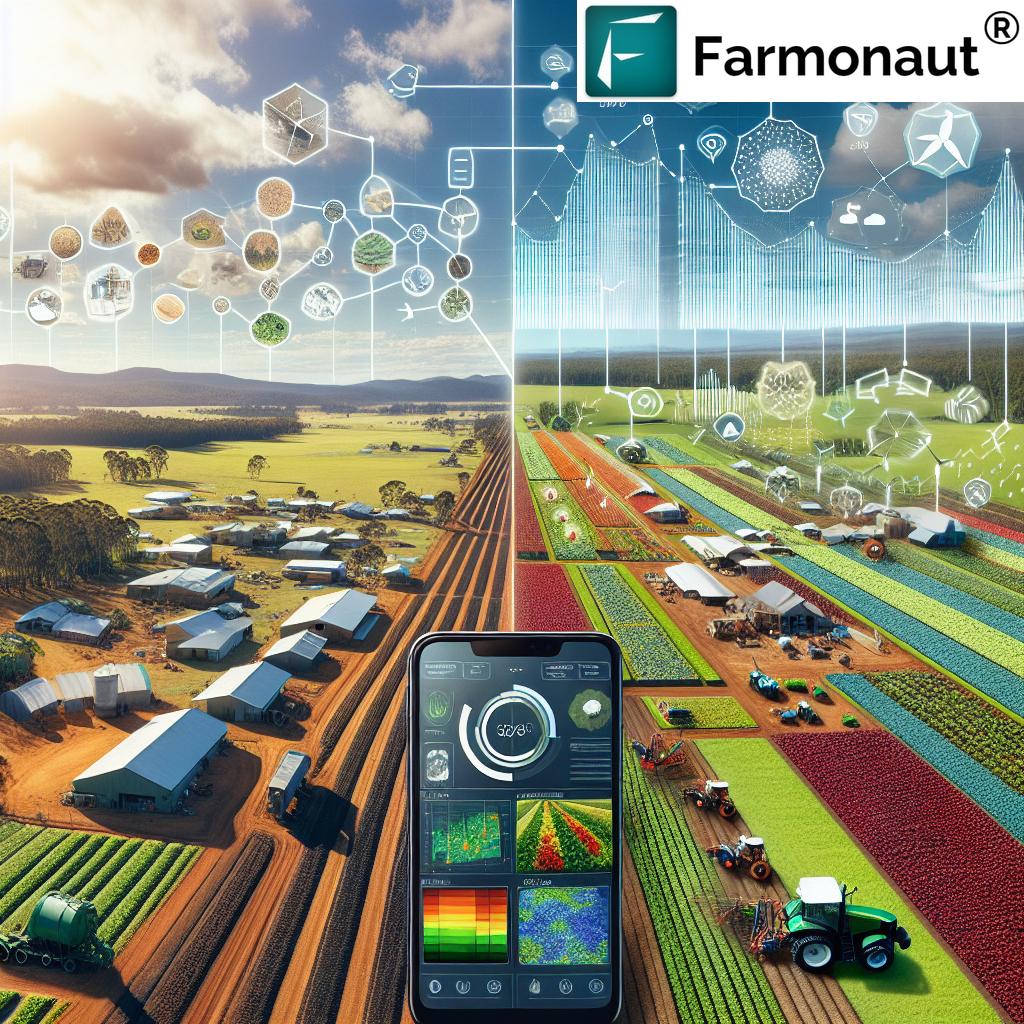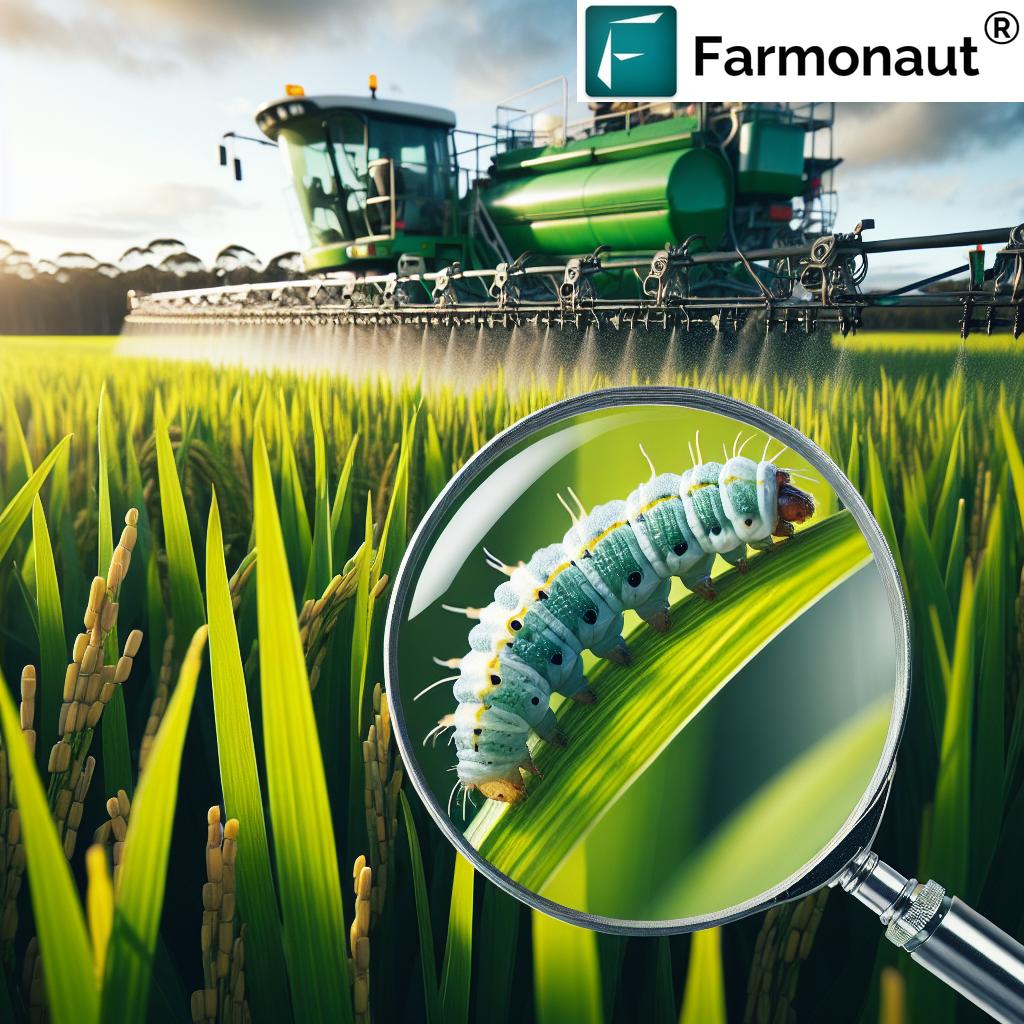Yield Monitoring NSW: 7 Tech Tips to Boost Profits
Table of Contents
- Trivia: Yield Monitoring in NSW
- Introduction: Why Yield Monitoring Matters in NSW
- Understanding Yield Monitoring
- Technological Advancements in NSW
- Benefits of Yield Monitoring in NSW
- Yield Monitoring Technologies Comparison Table
- 7 Tech Tips to Boost Profits with Yield Monitoring
- Leveraging Farmonaut’s Advanced Tools in Precision Agriculture
- Challenges and Considerations in Adopting Yield Monitoring in NSW
- Future Outlook for Yield Monitoring & Precision Agriculture in NSW
- Try Farmonaut Precision Ag Now!
- FAQs on Yield Monitoring in NSW
- Conclusion: The Profitable Future of Tech-Enabled Farming in New South Wales
“Yield monitoring tech in NSW can increase crop productivity by up to 20% through precise data-driven decisions.”
Introduction: Why Yield Monitoring Matters in NSW
Yield monitoring is the pivotal component of modern agriculture, empowering farmers in New South Wales (NSW), Australia to assess and boost crop output through precise data collection and analysis. The increasing adoption of advanced farming technologies and yield monitoring systems in NSW has transformed agricultural practices. This transformation enhances productivity, sustainability, and profitability by promoting data-driven farming decisions and enabling more efficient resource management.
In this comprehensive guide, we unveil 7 actionable tech tips for implementing successful yield monitoring and maximizing your farm’s profits and sustainability. Whether you manage a small family farm in rural NSW or a large-scale agribusiness, these strategies are designed to put you at the forefront of the precision agriculture revolution in South Wales.
Understanding Yield Monitoring in Modern NSW Agriculture
Yield monitoring involves the use of advanced technologies to measure and record the amount of crop harvested from specific field areas. Typically, this process employs sensors installed on harvesting equipment like combines. These sensors collect data on crop yield and moisture in real-time during each pass through the field.
The data collected is then analyzed and used to create yield maps, highlighting spatial variations in crop performance across the farm. These maps are invaluable for making informed decisions around resource allocation, soil management, and future planting strategies. This level of precision enables farmers in NSW to address field variability, optimize inputs, and drive higher yields at reduced costs.
How Does Yield Monitoring Work?
- Sensors: Mounted on harvesters to continuously measure yield and moisture content.
- Data Collection: Real-time advance data feeds are recorded as crops are harvested from each location in the field.
- Analysis: The system analyzes this information, flagging high-performing and low-performing field areas and spatial variations.
- Yield Maps: Visual maps make it easy to spot trends and variations across your property.
Why Is Yield Monitoring Important in South Wales?
With NSW agriculture facing growing resource constraints, changing climate, and market demands for sustainable practices, using accurate crop yield data analysis lets farmers respond to these challenges effectively:
- Promotes resource efficiency (water, fertilizer, labor)
- Guides precision application of inputs
- Supports sustainable agriculture practices
- Improves profitability and risk management
- Drives informed, data-driven farming decisions
Technological Advancements in Yield Monitoring Across NSW
NSW is at the forefront of adopting and integrating modern yield monitoring technologies. Several high-profile initiatives and projects are driving adoption, unlocking new potential for agricultural productivity and farm management in the region.
1. Farms of the Future Program (NSW Government)
- $33 million investment to improve on-farm technology & connectivity.
- Focuses on providing farmers with access to the latest tools, equipment, and training.
- Puts yield monitoring and precision agriculture at the center of transformative on-farm practices.
This initiative aims to:
- Integrate advanced yield data collection and precision ag tech into everyday operations
- Improve resource allocation and sustainability
- Empower farmers with skills, education, and ongoing support
2. DigiFarm Project (University of Sydney)
- Installed & tested digital soil moisture probes and water tank monitors on Llara Farm.
- Focus on understanding soil moisture, field constraints, and enabling accurate yield predictions.
- Empowers farmers with better management practices and higher yields through scientific data analysis and actionable insights.
3. Yield Prophet® (CSIRO)
- Integrates soil test results, weather data, and crop management for real-time yield potential assessment.
- Allows farmers to make informed decisions about resource allocation, input timing, and risk management.
- Reduces input costs and enhances profitability using data-driven recommendations.
“Over 65% of NSW farms adopting precision agriculture report improved sustainability and resource efficiency.”
Key Benefits of Yield Monitoring for Agricultural Productivity in NSW
Applying yield monitoring technologies brings a host of benefits, allowing farmers and agribusinesses to enhance sustainability, profitability, and agricultural productivity in NSW.
-
Enhanced Decision-Making:
- Yield maps provide actionable visualization of spatial variations in crop performance across fields.
- Enables informed intervention with variable-rate application (VRA) for fertilizers, water, and pesticides.
-
Improved Resource Management:
- Detailed understanding of field areas and variability guides targeted use of soil nutrients, irrigation, and labor allocation.
- Promotes more efficient, sustainable agriculture practices.
-
Increased Profitability:
- Focusing efforts on high-yield potential zones maximizes ROI.
- Reduces unnecessary input costs in unproductive field sectors.
-
Sustainability:
- Promotes sustainable use of resources, minimizing environmental impact.
- Supports ongoing soil health, improving farm resilience.
-
Risk Management:
- Historical yield data supports more accurate insurance claims and financial planning.
- Early warning of yield-constraining factors allows rapid response and damage prevention.
Yield Monitoring Technologies Comparison Table
To help you decide which precision agriculture technology best suits your farm, here’s a detailed comparison of yield monitoring solutions used across modern NSW agriculture:
| Technology Type | How It Works | Estimated Increase in Yield (%) |
Initial Investment Estimate (AUD) |
Data Insights Provided | Sustainability Impact |
|---|---|---|---|---|---|
| Satellite Imagery (e.g., Farmonaut) |
Uses multispectral satellite images to monitor crops, soil moisture, health, and more, providing field-level insight without on-farm hardware. | 12-18% | Low (From $75/year) | Vegetation Health (NDVI), Soil Moisture, Crop Stress, Weather, Anomalies | High |
| IoT Sensors (Soil/Water) | Digital probes & sensors installed in the field for continuous soil moisture, nutrient, and environmental data collection. | 7-13% | Medium (~$2,000+ | Soil Moisture, Temperature, Nutrient Levels | Medium |
| On-Board Yield Monitors | Sensors on harvesters track real-time amount and quality of crop as harvested; requires compatible machinery. | 10-15% | High ($7,000 – $20,000+) | Yield Quantity, Moisture, Field Maps | High |
| Drones | Aerial imagery for crop health, disease, and stress identification; typically requires skilled operators and software. | 8-14% | Medium ($1,500 – $10,000+) | Visual Crop Health, Hotspots, Emergence Issues | Medium |
| Crop Simulation Tools (e.g., Yield Prophet) | Combines soil tests, weather, management practices to simulate & predict yields throughout the season. | 5-10% | Low (~$200/season) | Predicted Yield, Stress Events, Input Optimization | Medium |
7 Tech Tips to Boost Profits with Yield Monitoring in NSW
1. Choose the Right Yield Monitoring System for Your Farm
Select a yield monitoring solution that fits your field size, existing equipment, and management style. For some, fitting sensors on harvesters offers the most direct in-field data. Others may benefit from satellite imagery-based platforms—like Farmonaut—which require minimal investment and offer scalable insights across all areas of your farm.
- Consider ongoing support and training requirements
- Factor in compatibility with existing farm management systems
- Evaluate overhead costs versus yield gains and sustainability impact
2. Leverage Yield Maps for Variable Rate Application (VRA)
Yield maps provide granular insights into your field’s spatial variations. By linking yield data with precision spreaders and planters, apply fertilizer, water, and pesticides only where needed—improving resource efficiency and maximizing crop output in NSW’s varied soils.
- Reduce input costs
- Boost agricultural productivity in NSW while minimizing run-off & waste
3. Integrate Soil Moisture Monitoring with Yield Data
Soil moisture monitoring gives actionable insights into the water needs of each field. By linking this with your yield maps, you can optimize irrigation scheduling, boost crop performance, and improve water use efficiency—critical for both profitability and sustainability.
- Install smart soil moisture probes, or use satellite-derived moisture data
- Fine-tune irrigation applications to reduce water waste and environmental impact
4. Use Predictive Analytics to Guide Planting and Resource Allocation
Tools like Yield Prophet® and Farmonaut’s satellite-based crop health monitoring harness AI and advanced analytics to predict yield potential based on real-time data collection, soil health trends, and historical performance. This guides decisions on crop selection, planting strategies, and input allocation for the next season.
- Reduce risk by targeting high-opportunity field zones in NSW
- Boost agricultural productivity and mitigate variability across the farm
5. Automate Data Collection and Visualization with Cloud Solutions
Using platforms that automatically collect, analyze, and visualize data (including yield, moisture, weather, and crop health) allows farmers to make fast, informed decisions. Farmonaut’s web, Android, and iOS Apps are designed for seamless remote access—empowering farm managers and teams with real-time information for every field, anywhere.
- Minimize manual data entry & potential errors
- Enable collaborative management with cloud-based large scale farm management solutions
6. Prioritize Training & Upskilling for Effective Technology Adoption
The biggest barrier to getting the most from technology is often the lack of training or technical skills. Invest in upskilling not just for yourself but for the whole team. Many suppliers—including Farmonaut—offer guides, videos, and support. Consider field days and NSW Government programs that focus on smart technology education so your team can implement and troubleshoot with confidence.
- Continuous learning ensures your yield monitoring technology investment pays off
- Boosts long-term farm profitability and technology effectiveness
7. Monitor and Report Sustainability Impact
Many buyers, insurers, and financiers demand evidence of sustainable agriculture practices. Use data from yield monitoring to demonstrate resource efficiency, reduced input usage, and improved soil health.
Solutions such as Farmonaut’s Carbon Footprinting let you measure and minimize your environmental impact—providing data for compliance, certification, and branding.
- Share your progress with stakeholders
- Position your produce and business for the future of sustainable NSW agriculture
Leveraging Farmonaut’s Advanced Tools for Precision Agriculture in NSW
At Farmonaut, our core mission is to make precision agriculture affordable and accessible to farmers globally, including those in NSW. By integrating satellite-based crop monitoring, AI-driven advisory systems, blockchain traceability, and resource management tools, we empower NSW farms to capture the full potential of yield monitoring and advanced farming technologies.
Our Technologies: Transforming Data Collection into Actionable Insights
- Satellite-Based Crop Health Monitoring: Receive timely updates on NDVI, soil moisture, and crop stress—so every agronomic decision is informed and precise.
- Jeevn AI Advisory System: Get personalized crop and weather alerts, resource management recommendations, and seasonal strategy—all powered by real-time satellite inputs.
-
Blockchain-Based Traceability: Assure buyers and consumers of your product’s origin and journey.
Learn more about Farmonaut’s traceability solutions. -
Fleet and Resource Management: Optimize machinery use, route planning, and input logistics with real-time tracking.
Explore our farm fleet management tools. -
Carbon Footprinting: Track emissions and environmental impact to comply with sustainability standards and maximize resource use efficiency.
See how Farmonaut carbon tracking works.
Our API access also lets agritech developers and agricultural businesses integrate real-time satellite and weather data into their own systems, supporting scalable and collaborative research solutions.
Try the Farmonaut Satellite & Weather API |
API Developer Docs
Challenges & Considerations in Adopting Yield Monitoring in NSW
While yield monitoring technologies offer significant advantages, NSW farmers must consider several challenges and plan accordingly:
-
High Initial Investment:
- Onboard yield monitors and field sensors can be costly.
- Satellite-based solutions like Farmonaut lower the barrier and scale per hectare.
-
Data Management & Analysis:
- Yield monitoring generates large volumes of data. Effective farm management systems and user-friendly visualization are key.
-
Technical Expertise:
- Training on the new equipment and digital platforms is essential for success.
-
Integration with Existing Systems:
- Evaluate compatibility upfront—ensure sensor, cloud, and app solutions can be integrated with current machinery and management practices.
-
Connectivity Issues:
- Remote farms may lack stable internet; opt for platforms that support offline data and remote syncing.
Tip: NSW government programs and ongoing training courses can help overcome adoption challenges and build local expertise!
Future Outlook: Precision Agriculture & Yield Monitoring in NSW
- Technology Advancements: Ongoing innovation promises greater data accuracy, device interoperability, and analytics capabilities.
- Government Support: Programs like Farms of the Future will continue supporting technology adoption and infrastructure upgrades.
- Collaborative Research: Projects such as DigiFarm are refining yield modeling and soil-crop understanding.
- Education and Training: Expansion in digital agriculture education at Queensland and New South Wales institutions will raise the skillset of new and established farmers.
- AI-Driven Farm Management: Expect seamless, integrated farm management systems that blend AI, blockchain, and real-time satellite insights for unrivaled productivity and sustainability.
Try Farmonaut’s Precision Agriculture Tools
Ready to experience the benefits of yield monitoring and advanced farming technology on your NSW farm? With Farmonaut, adoption is easy, scalable, and tailored for both smallholders and large-scale operators.
Have a large plantation or need coordinated advisory for corporate, government, or research projects? Explore our large-scale farm management dashboard.
For seamless crop insurance or loan verification, see Farmonaut’s automated crop loan and insurance tools.
For advanced plantation and forestry advisory, access our tailored guidance modules.
FAQs: Yield Monitoring & Precision Agriculture in NSW
Q1: What is the main benefit of yield monitoring for farmers in NSW?
Yield monitoring empowers farmers to measure and visualize spatial variations in crop performance, enabling efficient allocation of resources, boosted productivity, reduced input costs, and improved sustainability—key drivers for long-term profitability in NSW agriculture.
Q2: Can yield monitoring systems integrate with my existing farm machinery and management practices?
Many modern yield monitoring systems are designed for integration with common farm management systems in NSW, as well as popular machinery brands. Solutions based on satellite data, such as those provided via the Farmonaut platform, require minimal hardware upgrades.
Q3: Is a lot of technical expertise required to use yield monitoring technology?
While some initial training is helpful, leading solutions are increasingly user-friendly. Providers (including Farmonaut) offer onboarding support, tutorials, and helpdesks for ongoing assistance.
Q4: What sustainability impacts can I demonstrate using yield monitoring?
By quantifying input reductions, documenting reduced runoff & improved soil health, yield monitoring data is ideal for proving compliance, earning sustainability certifications, and qualifying for eco-friendly brand premiums.
Q5: How affordable are satellite-based platforms compared to traditional sensor solutions?
Satellite- and app-based yield monitoring solutions dramatically reduce upfront investments, charging per season or per hectare—with global access. Traditional on-farm sensors and vehicle-mounted monitors often involve substantial hardware investment and setup costs.
Conclusion: Building a Profitable, Sustainable Future for NSW Agriculture
The future of farm productivity and sustainability in New South Wales hinges on the widespread adoption of yield monitoring and precision agriculture technologies. These solutions enable farmers to assess, analyze, and enhance crop performance in ways never before possible—delivering measurable profitability and resilience amidst South Wales’ evolving agricultural landscape.
By choosing the right technologies, upskilling your workforce, and acting on actionable data-driven insights, NSW farms will thrive in both present markets and a rapidly digitizing, sustainability-focused future for global agriculture.
We, at Farmonaut, are committed to driving this transformation—helping farmers and agribusinesses access affordable, advanced solutions that make precision agriculture a reality across every field in NSW and beyond. The tools are here. The time to act is now.














